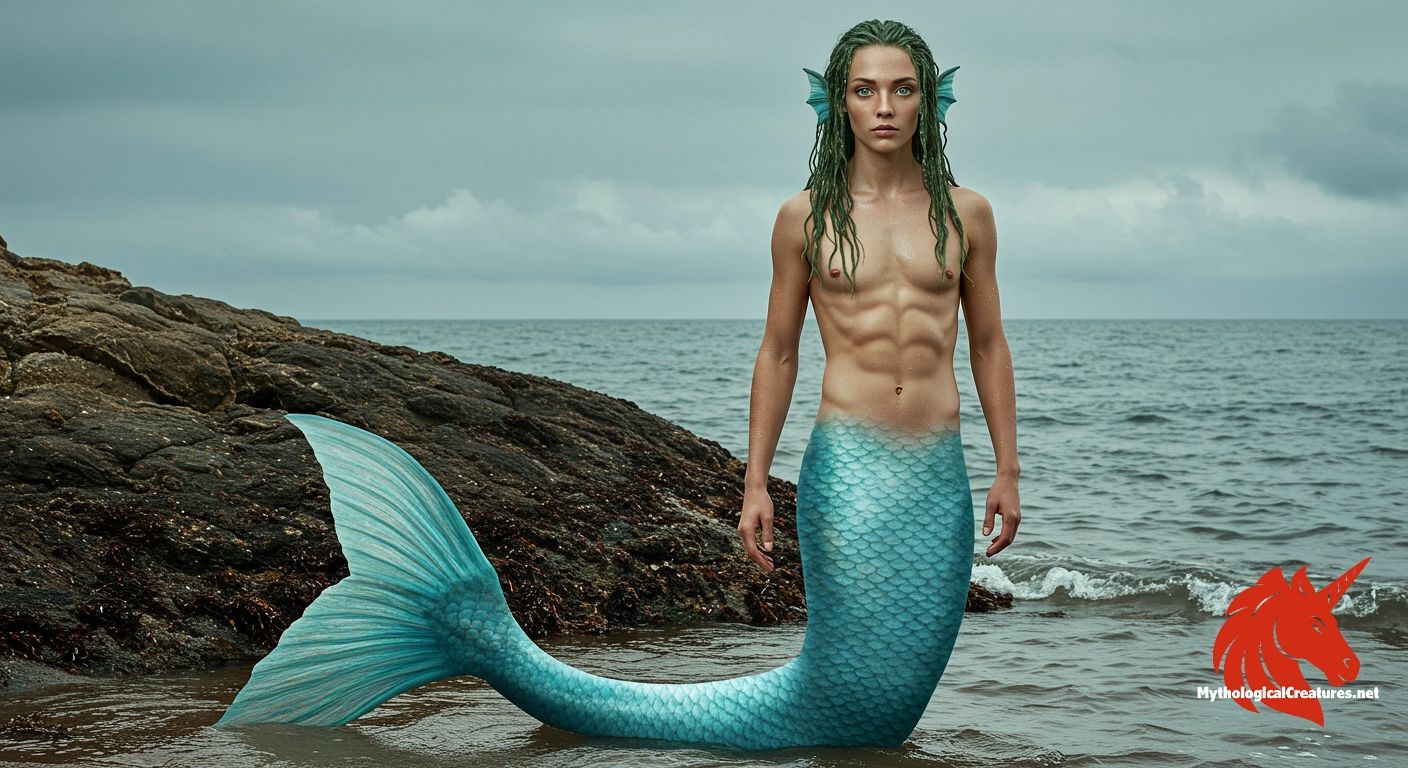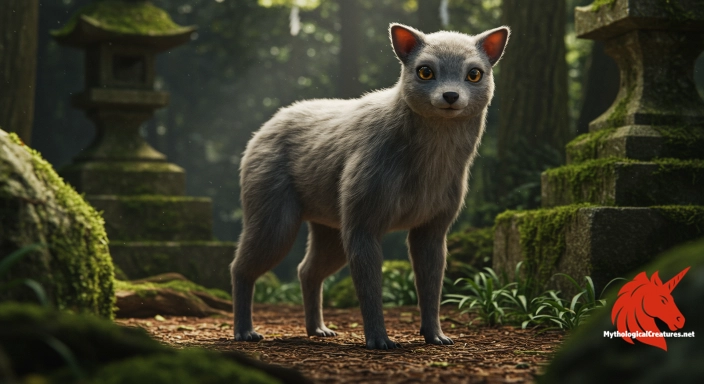Merrow: Merrows are mythological aquatic beings from Irish folklore, depicted as mermaids or mermen that combine human and fish characteristics.

Merrow
Merrow - Merrows are significant in Irish folklore as beings that bridge the divide between the sea and the land through their unique magical cap.
Origins & First Encounters
Merrow are enigmatic denizens of the Irish seas whose legends have been passed down through centuries, reflecting a deep connection between the natural and supernatural worlds. Their origins lie in ancient Celtic traditions, woven into the cultural fabric of medieval and early modern Ireland. The name itself is derived from the Irish word murúch, a linguistic marker that hints at their mysterious nature. Various narratives portray them as either alluring mermaids or robust mermen, each embodying elements of both human familiarity and the wildness of the ocean. These mythic figures have persistently captivated the imagination of coastal communities, symbolising both the beauty and danger inherent in the sea. Their existence is traditionally linked to a magical cap, an enchanted object that enables passage between the realms of deep water and dry land. Folktales often depict the merrow as bridging opposites—between the known and unknown, safety and peril, land and sea. Over time, their stories have evolved, incorporating layers of symbolism that resonate with themes of transformation and liminality. The merrow’s enduring appeal lies in their ability to evoke the mystery of nature, making them a cherished emblem in Irish folklore. Their narrative continues to be retold with a blend of elegance and enigma, underscoring a timeless cultural legacy.
Source Texts & Tale Variants
Early mentions of the merrow are scattered throughout medieval manuscripts and the rich oral traditions of Ireland, where they are interlaced with regional maritime lore. Although few formal texts provide exhaustive accounts, these fragmented sources offer a kaleidoscopic view of a creature whose myth has been shaped by successive generations. Folk ballads and local legends have enriched the narrative by offering variant stories that describe the merrow in both benevolent and cautionary roles. Some storytellers recount encounters that suggest the merrow bestows gifts or warnings upon seafarers, while other versions emphasise a more eerie and elusive presence. The magical cap, often referred to in these traditions, is treated as an essential artefact that confers the power to travel between contrasting realms. Diverse accounts can be found in regional folklore collections, where the merrow is sometimes mentioned alongside other water spirits and coastal deities. These primary sources, though varied, illustrate a broader pattern of myth-making that adapts to local cultural and environmental influences. The oral narratives have allowed the legend to evolve, with each retelling adding layers of detail and nuance to the core myth. Even in the absence of a single authoritative text, the collective body of sources provides valuable insights into how the merrow has been perceived over time. This multiplicity of voices contributes to a rich and multifaceted tradition that continues to intrigue both scholars and enthusiasts.
Form & Powers
Descriptions of the merrow paint a picture of a creature that is at once quintessentially human and undeniably aquatic, possessing a mesmerizing blend of features from both worlds. They are typically depicted with the graceful upper body of a human, complemented by a powerful, scaly tail that reflects the myriad hues of the sea. Their hair is often portrayed as long and flowing, evoking images of seaweed tumbling in the ocean currents, while their eyes shimmer with the deep, reflective quality of water. Intricate details frequently include hints of iridescence in their skin and an almost ethereal glow that suggests an origin beyond mortal realms. The magical cap, a constant element in their lore, is sometimes depicted as a small, brilliantly adorned item that plays a critical role in their ability to navigate between aquatic and terrestrial life. Variations in the descriptions sometimes extend to subtle differences in stature and build, with some accounts presenting them as delicate beings, and others as robust figures capable of enduring harsh marine conditions. Observers in folklore note that their movements are imbued with an otherworldly grace, seamlessly blending the fluidity of water with the poise of a human form. This dynamic visual portrayal encapsulates both the allure and the enigmatic danger of the ocean, making the merrow a figure of perpetual fascination. Each description, rich in metaphor and detail, underscores the duality of beauty and mystery that is central to their myth. Their physical appearance remains a vivid testament to the enduring power of myth to blend the familiar with the fantastical.
Regional Faces
The characterisation of the merrow exhibits distinct regional variations that reflect the diverse coastal traditions of Ireland and neighbouring cultures. In the western seaboard, where the wild Atlantic meets rugged cliffs, merrow legends often cast them as benevolent protectors of the sea, closely watched over by local fishing communities. In other regions, particularly along the more temperate eastern shores, accounts may imbue the merrow with an ominous aura, suggesting their presence as harbingers of both fortune and misadventure. Local adaptations sometimes incorporate unique elements such as specific rituals or landmarks associated with their sightings, linking the creature to particular coves, inlets, or even ancient stone circles near the shore. The magical cap, consistently highlighted in these tales, is often depicted with regional flourishes—its design and mystical properties subtly shifting in accordance with local beliefs. In parts of Scotland and the Isle of Man, similar water spirits emerge in folklore, revealing a shared narrative tradition that spans across cultural and geographical boundaries. These regional narratives not only enrich the merrow myth but also illustrate how environmental differences can influence the portrayal of mythological beings. Communities tailor the myth to mirror their experiences with the unpredictable sea, whether it manifests as a nurturing force or a capricious power. The result is a captivating mosaic of interpretations, where the merrow remains a central, yet flexible, figure in maritime folklore. Such regional diversity underscores the importance of local context in keeping the ancient myth alive and relevant across generations.
Cultural Parallels
The merrow occupies a fascinating position in the broader tapestry of global maritime mythology, where parallels can be drawn with similar water-bound entities from diverse cultural backgrounds. Much like the Greek siren or the Scandinavian merman, the merrow embodies a duality that is both enchanting and foreboding, symbolising the unpredictable nature of the sea. Each of these creatures, regardless of their cultural origins, reflects an intrinsic human desire to understand and personify the forces of the ocean. While the siren is often associated with fatal enticement and the merman with mystic strength, the merrow’s narrative bridges these concepts by combining elements of allure with an undercurrent of melancholic mystery. Their distinctive magical cap further distinguishes them, representing a unique emblem of transition and transformation not commonly found in other maritime myths. Comparative analysis reveals that water spirits across cultures share themes of liminality, serving as both guides and gatekeepers between worlds. In numerous traditions, the sea is a canvas on which the interplay of beauty and peril is vividly painted, and the merrow epitomises this balance. By examining these similarities and differences, one can appreciate how the merrow contributes to a universal narrative about nature’s power and unpredictability. Ultimately, the merrow resonates with a global symbolic language, illustrating that while the details may vary, the essential human experience of the deep sea is remarkably consistent. Such cross-cultural connections highlight a shared heritage of myth-making that continues to captivate and intrigue.
Legacy & Modern Evolution
The myth of the merrow has evolved considerably over the centuries, transitioning from a localized folklore figure to a broader cultural icon imbued with layers of symbolism. Initially, these sea beings were primarily featured in oral traditions and regional ballads, where their mysterious nature served as a metaphor for the unpredictable and often treacherous sea. Over time, the merrow came to be celebrated in literary works, artworks, and local festivals, each medium adding new dimensions to the legend. Modern reinterpretations often cast the merrow not only as a creature of whimsy and wonder but also as an allegory for transformation and the fluid boundary between the known and the unknown. The magical cap, once a simple mystical object, has been reimagined as a potent symbol of change and the ability to navigate different realms, both literal and figurative. Contemporary narratives incorporate environmental and existential themes, reflecting humanity’s ongoing relationship with the natural world. Artists and writers alike draw on the merrow’s rich tableau of characteristics to explore issues of identity, belonging, and the passage of time. The enduring legacy of the merrow is evident in its presence within modern cultural expressions, from fantasy literature to visual art, where it continues to inspire and evoke a sense of mystic nostalgia. This longstanding appeal underscores the merrow’s position as a timeless emblem of maritime myth, one that evolves yet remains deeply rooted in the collective imagination. Today, as the line between myth and modernity increasingly blurs, the merrow stands as a testament to the resilient power of folklore in capturing the essence of the human encounter with nature.
Interesting Fact
An intriguing aspect of the Merrow myth is the essential role of the magical cap, which not only symbolizes their unique dual existence but also underscores a rare instance of an artifact granting a creature the ability to bridge vastly different realms.
Quick Creature Info
Features:
Associations:
Our Mythic Legendary Rating:

Also Sometimes Known As:
Habitat:
Supernatural Powers:
Physical Attributes:
Abilities:
Weaknesses:
Lore:
References
Discover Another Mythical Legend You May Not Have Heard Of?
Uncover the mysteries of ancient folklore and expand your knowledge of legendary beings from cultures around the world.
Dare to Meet the Keukegen....
Mythical Disclaimer: The images and data on this site are derived from various historical and literary sources, but we have found that many myths often have multiple versions and interpretations across references, sometimes contradictory. As a result, these creature depictions are artistic interpretations—imaginative blends of folklore, legend, and a dash of AI guesswork. Because creature descriptions vary widely, our illustrations and accompanying information represent our best effort to honor mythology while bridging creative gaps. Enjoy these interpretations—just remember, we've done our best to respect the stories and validate available data, but in the realm of mythology, details often shift, imagination leads the way, and nothing is ever set in stone!
Curated by the Mythological Creatures Team (rev. May 2025)
